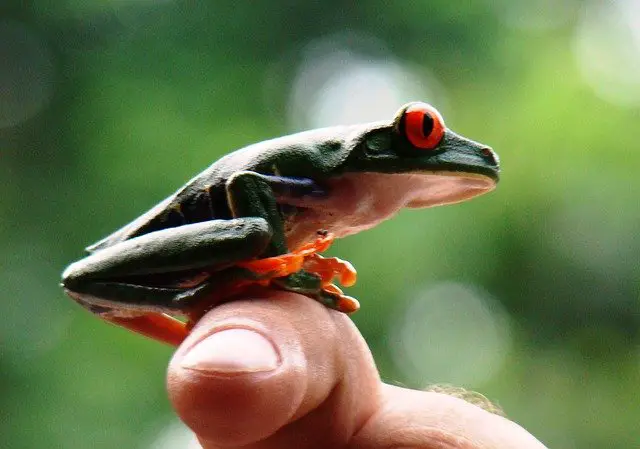Red-eyed tree frogs are small amphibians ranging between just 2-4 cm in size, so, naturally, they would have many predators out in the wild. Their bright coloring may be intriguing to humans, but to other animals, it makes them a target. From birds, snakes, and spiders, many animals consider this tropical amphibian to be a tasty treat.
Predators When Full Grown
Birds
The tropical parts of Central and Southern America where red-eyed tree frogs are found is also home to many species of birds that like to prey on these amphibians. Birds can fly at a moment’s notice and swoop on these amphibians which is why they are highly dangerous. Some of the most popular bird predators to tree frogs are toucans, owls, and hawks.
While birds are a common threat to tree frogs, the amphibians’ bright coloring and quick movements often distract these predators for a split second that is long enough for the frogs to escape. Tree frogs must be able to jump to safety very quickly in order to not become a meal.
Bats
Many predators of red-eyed tree frogs are often nocturnal hunters, like bats. These bird-like mammals do not rely on sight to hunt because of their poor vision and instead use echolocation to detect their prey. This hunting skill is what makes them a huge predator to these amphibians and often is what makes them more successful than other predators who are typically distracted by the tree frog’s bright coloring.
Snakes
Larger snake breeds may overlook the red-eyed tree frog as a source of food, but smaller snake breeds love these amphibians for their rich nutrition and abundance of eggs. Many snakes do not look specifically for this amphibian but instead come across them on accident while slithering across the forest floor or climbing rainforest trees.
While snakes will eat tree frogs when they can, they are often more attracted to their eggs. Red-eyed tree frog eggs are usually easier to find because they cannot escape at a moment’s notice. In order for a snake to eat this amphibian, it has to either catch it off guard or be faster in movement.
Spiders
Not all spiders are hungry for amphibians, but the ones that tend to be a huge threat to red-eyed tree frogs. Tarantulas are the most common predator to these frogs because they are large enough to take them down. They also have an advantage of silence and sneakiness that can turn an unsuspecting tree frog into a quick meal, however, the tree frogs’ ability to quickly escape is what protects them from this disadvantage.
Monkeys
With all the other options that monkeys have for food, it may seem silly that red-eyed tree frogs are on their radar as a source of nutrition, but in the wild, every animal must take what they can get to survive. Monkeys will eat red-eyed tree frogs when they are found roaming about the trees, but they usually prefer the eggs over the actual amphibians.
What makes monkeys a primary predator to the red-eyed tree frog is their ability to grab their food with their hands. A monkey is often less fooled by the color tricks of this amphibian and is able to simply snatch it right when it is seen.
Alligators
Smaller breeds and young alligators are another common threat to red-eyed tree frogs. Young alligators who are not highly skilled hunters yet prey on these amphibians as any easy source of food. Smaller breeds who do not need to spend as much time or energy acquiring each meal will also eat these tree frogs when they can.
When red-eyed tree frogs are ready to lay their eggs, they typically do it under a leaf near a water source. This brings this amphibian closer to alligator territory, where they are often distracted with completing the last stage of the reproduction process. Alligators are then able to catch them off guard and turn them into an easy snack.
Predators As A Tadpole
Dragonflies
Red-eyed tree frogs are looked at as food in every life stage, from eggs to tadpoles and of course as a frog. When these amphibians are in the tadpole stage of their lives there are many water predators that will look for them as a food source.
Dragonflies spend most of their lives as nymphs underwater and commonly prey on small creatures like tadpoles for their nutrition. Dragonflies are huge predators when it comes to red-eyed tree frog tadpoles who must be quick enough to escape the surprise attack from this underwater insect.
Fish
Smart tree frogs will lay their eggs near a source of water that has minimal or no fish at all. This is because tadpoles do not have a very high chance of surviving any fish inhabited waters. Many species of tropical fish will eat red-eyed tree frog tadpoles as soon as they can find them. This makes the water a very dangerous place for unsuspecting tree frog tadpoles.
Water Beetles
While some water beetles may only eat aquatic vegetation, there are also predatory water beetles that love to snack on tadpoles. These beetles are small and quick, which makes their opportunities of catching red-eyed tree frog tadpoles fairly high. These tadpoles may not see a water beetle coming when they are more focused on looking out for fish.




